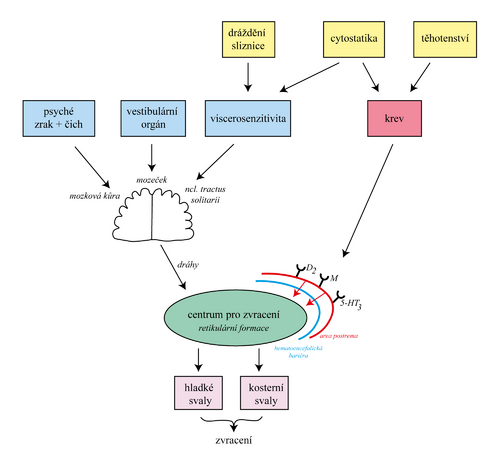Vomiting
Vomiting is a term for sudden, nerve-controlled oral (or pernasal) excretion of digestion from the stomach or duodenum, caused by spasmodic contractions of the abdominal and diaphragmatic muscles . Vomiting is an important defensive reflex.
Stages of vomiting[edit | edit source]
Vomiting as a defensive reflex has several stages:
- intensive salivation (enamel protection) and nausea ,
- reversal of peristalsis (transfer of digestion from the upper floors of the intestine back to the stomach),
- closure of the glottis (prevents inhalation, aspiration, vomiting),
- holding your breath in mild inspiration,
- contraction of the abdominal wall muscles (abdominal press) and increase in intra-abdominal pressure,
- relaxation of the lower esophageal sphincter,
- emptying of the stomach [1].
Nervous control of vomiting[edit | edit source]
Vomiting is coordinated by the nerve centers in the medulla oblongata in several ways:
- vagus nerve (Parasympathetic, serotonin via 5-HT 3 receptors),
- Splanchnic nerves (thoracic sympathetic nervous system), which innervates the internal organs of the abdominal cavity,
- fibers from the vestibular system (H1 histamine and M1 cholinergic receptors),
- reactions to stimuli, visual, olfactory, emotional, but also anticipatory vomiting in chemotherapy
- area postrema − chemoreceptive trigger area (opioid, 5-HT 3 , and D 2 dopamine receptors), stimulation may be uremia, hypoxia, ketoacidosis. [2].
Knowledge of receptors is used in therapy.
Causes of vomiting[edit | edit source]
The causes of vomiting include a wide range of diseases, acute and chronic vomiting can be distinguished. In most cases, it is accompanied by nausea.
- GIT disease
- acute: gastroenteritis, pancreatitis, cholecystitis, appendicitis , small intestine obstruction, hepatitis ,
- chronic: esophageal reflux disease, achalasia, esophageal diverticulum, gastrointestinal stenosis, gastroduodenal ulcer, postoperative complications such as strictures, but also functional disorders ,
- endocrinopathies − Addison's disease, thyroid diseases (hyperfunction and hypofunction), complications in Diabetes mellitus (ketoacidosis in type I DM),
- malignancies − cancer of the GIT (pancreas), but also elsewhere - bronchogenic ca., brain tumors,
- neurological diseases − intracranial hypertension , migraine , head trauma (acute vomiting),
- psychiatric illnesses − depression, anxiety, bulimia ,
- non-GIT infections − urinary tract infections,
- certain drugs (anticancer chemotherapy, oral antidiabetics (metformin), antibiotics (erythromycin), opioids , antiparkinsonian drugs , antiarrhythmics , digoxin ), antiarytmika, digoxin),
- alcohol, drugs.
Projective vomiting (acute vomiting without prior nausea) is typical in intracranial hypertension and in young children with hyperkalaemia and pyloric stenosis. A special type of vomiting is miserere (vomiting of the intestinal contents).
Complications[edit | edit source]
Vomiting can have serious consequenes – especially in recurrences it causes dehydration, hypochloraemia , hypochloraemic alkalosis, as a result of increased ion excretion, their imbalance occurs. It prevents the patient from eating and thus also causes nutritional problems. During strong contractions, the esophagus may rupture, causing blood to vomit (Mallory-Weiss syndrome). Complications of vomiting include aspiration of vomit, which usually results in aspiration pneumonia.
Patient examination[edit | edit source]
The most important part is the anamnesis, which then guides us to further investigation procedures.
- dependence of vomiting on food − before food (pregnancy, uremia, psychogenic),
- pain − in duodenal ulcer, the pain disappears after vomiting,
- relief after vomiting – typical relief after vomiting from stomach causes (acute gastritis, peptic ulcer), on the contrary, relief does not occur from vomiting from pancreatic or gallbladder causes (so-called reflective extragastric type of vomiting)
- contents of the vomit − if it contains undigested food, it may be achlorhydria ; if it contains undigested food that has been delayed for a long time, it may be stenosis, esophageal diverticulum ,…
- blood − fresh (esophageal varices, Mallory-Weiss syndrome ), older blood in the nature of coffee grounds (bleeding into the upper part of the GIT),
- bile.
Other examination methods include laboratory biochemical examination, USG, EGG , endoscopic methods, CT.
Treatment[edit | edit source]
Mild forms of vomiting usually go away without the need to start therapy, rehydration of the body, diet is important . We approach antiemetics only in more severe forms of vomiting (vomiting after chemotherapy, acute pancreatitis). The basic groups of antiemetics are:
- parasympatholytics,
- antihistamines,
- phenothiazines,
- 5-HT 3 -receptor antagonists ,
- prokinetics.
The treatment of complications - dehydration, metabolic and ionic breakdown - is important. Change of habits is recommended for vomiting in early pregnancy - smaller doses of food served more often, neutrality in sensory perception is important (non-spicy, non-fat). For the treatment of vomiting during chemotherapeutic treatment, it is very important that vomiting is prevented from the beginning. Later therapy is more complicated and chemotherapy as such is less well tolerated.
Links[edit | edit source]
Related articles[edit | edit source]
Source[edit | edit source]
- ws:Zvracení
- https://pl.wikipedia.org/wiki/Wymioty
- Klener, Pavel. Vnitřní lékařství. 3. přepracované a doplněné vydání. Praha : Karolinum : Galén, c2006. ISBN 80-7262-430-X. Strana 29.
References[edit | edit source]
- ↑ KITTNAR, Otomar. Lékařská fyziologie. 1. edition. Grada, 2011. 358 pp. ISBN 978-80-247-3068-4.
- ↑ LUKÁŠ, Karel – ŽÁK, Aleš. Chorobné znaky a příznaky : 76 vybraných znaků, příznaků a některých důležitých laboratorních ukazatelů v 62 kapitolách s prologem a epilogem. 1. edition. Grada, 2010. 219 pp. ISBN 978-80-247-2764-6.

